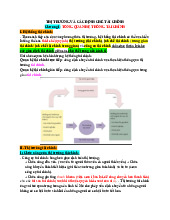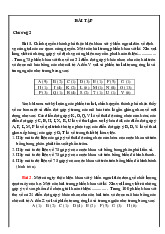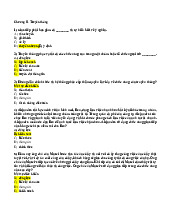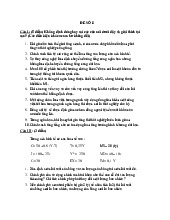




Preview text:
lOMoARcPSD| 50032646
1. What are the characteristics of instruments in the money market?
Short Maturity, Low Risk, High Liquidity, Fixed Return, Issued in Large
Denominations, Low Yield
2. Who issues instruments in the money market? Who invests in the money market?
Who Issues Money Market Instruments?
- Governments (Treasury Bills) -
Financial Institutions:
- Corporations (Commercial Paper)
- Municipal Governments: - Central Banks
Who invests in the money market?
Institutional Investors, Governments, Individual Investors, Banks, Corporations
3. Why are most instruments in the money market always issued at a discount from their face value?
4. What is the purpose of issuing Treasury bills?
· Short-Term Financing: To cover short-term cash flow gaps and meet immediate expenses.
· Debt Management: To finance short-term debt without committing to longterm borrowing.
· Monetary Policy: Central banks use T-bills to regulate money supply and control interest rates.
· Safe Investment: T-bills offer a low-risk investment option for individuals and institutions.
· Funding Specific Needs: To raise funds for short-term projects or emergencies.
5. What are the disadvantages of commercial paper?
-It’s unsecured, relying on the issuer's creditworthiness, leading to default risk.
-Only large, established companies can issue it, excluding smaller firms. -
Availability and pricing can fluctuate with market conditions, making it harder to
issue during economic downturns. lOMoARcPSD| 50032646
-Companies may struggle to roll over maturing commercial paper in tough market conditions.
6. How can the risk of commercial paper be reduced?
-Consider investing in mutual funds or money market funds that specialize in high-
quality commercial paper, as they typically perform thorough credit analysis.
-Keeping an eye on broader economic indicators can help investors anticipate
potential defaults and make timely adjustments to their portfolios.
-Investors should rely on credit ratings from agencies to assess the
creditworthiness of the issuing company. Higher-rated issuers are less likely to default.
-Investors can reduce risk by diversifying their investments across different issuers
and sectors, minimizing exposure to any single issuer's potential default.
7. Why do companies still want to issue commercial paper instead of banker’sacceptances?
Because commercial paper offers companies more flexibility, lower costs, and
direct access to funding, making it a preferred choice for short-term financing.
8. What does the fee of banker’s acceptances depend on?
-Higher credit ratings typically lead to lower fees.
-Prevailing interest rates can influence the fee; higher rates may result in higher fees.
-Banks may have different fee structures based on the amount and duration of the acceptance.
-Longer maturities may involve higher fees due to increased risk.
-High demand can lead to higher fees.
-Broader economic factors can affect perceived risk and fees.
9. What is the collateral in a repurchase agreement?
In a repurchase agreement (repo), the collateral is typically a financial asset that
the seller (borrower) offers to the buyer (lender) to secure the loan 10.
What is the difference between a certificate of deposit and other money marketinstruments? -Issuance: lOMoARcPSD| 50032646
· CDs are issued by banks and financial institutions.
. Other Money Market Instruments (like Treasury bills, commercial paper, and
repurchase agreements) can be issued by governments, corporations, and
financial institutions. -Interest Payments:
· CDs typically pay interest at maturity or periodically, and they have a fixed interest rate.
. Other Money Market Instruments may be sold at a discount (like T-bills) or may
not pay periodic interest (like commercial paper). -Liquidity:
· CDs usually have a fixed maturity period and may incur penalties for early
withdrawal, affecting liquidity.
. Other Money Market Instruments are generally more liquid and can be bought
and sold in secondary markets more easily. -Risk:
· CDs are insured up to a certain limit by government agencies (like the FDIC in
the U.S.), making them very low-risk.
. Other Money Market Instruments vary in risk; for example, T-bills are lowrisk,
while commercial paper can carry more credit risk depending on the issuer. - Maturity:
· CDs typically have longer maturities than most money market instruments,
which usually have maturities of one year or less.
. Other Money Market Instruments are often short-term, with maturities ranging
from overnight to 270 days.
11. What are the advantages and disadvantages of a certificate of deposit compared tosavings deposits? Advantages of CDs
1. Higher Interest Rates: Generally offer better returns than savings deposits.
2. Fixed Returns: Interest rates are fixed for the term, ensuring predictable earnings. lOMoARcPSD| 50032646
3. Security: Usually insured by government agencies (e.g., FDIC).
4. No Market Risk: Not subject to market fluctuations. Disadvantages of CDs
1. Limited Liquidity: Funds are tied up for a fixed term, with penalties for early withdrawal.
2. Lower Flexibility: Fixed terms may not suit those needing quick access to funds.
3. Inflation Risk: Real returns can be negative if inflation exceeds interest rates.
4. Opportunity Cost: Locking in funds may result in missing better rates elsewhere.
12. Why do term deposits dominate over certificates of deposit in Vietnam?
-Term deposits are more commonly understood and utilized by Vietnamese
consumers, making them a preferred choice for saving.
-The regulatory framework in Vietnam may be more conducive to traditional term
deposits, leading banks to offer these products more prominently. -Many banks in
Vietnam primarily promote term deposits, which can be more appealing due to
their straightforward structure and fixed interest rates. -Vietnamese savers may
prefer the more flexible liquidity options associated with term deposits, which can
offer shorter maturity periods compared to CDs.
13. Why are certificates of deposit increasingly preferred over term deposits indeveloped countries?
Certificates of Deposit (CDs) are preferred over term deposits because:
-Higher Interest Rates: CDs often offer better returns.
-More Flexibility: CDs provide various terms and withdrawal options.
-Liquidity Options: Some CDs allow early withdrawal or additional deposits.
-Safety: CDs are typically insured, making them secure investments.
-Bank Promotions: Financial institutions promote CDs more actively.
-Market Conditions: In low-interest-rate environments, CDs offer competitive returns.
14. Among money market instruments, if they have the same term and face value,which
type has the highest interest rate? Which type has the lowest interest rate?
Highest Interest Rate: Commercial Papers lOMoARcPSD| 50032646
Lowest Interest Rate: Treasury Bills
15. Among money market instruments, if they have the same term and face value,which
type is sold at the lowest price? Which type is sold at the highest price?
Lowest Price: Commercial Paper
Highest Price: Treasury Bills
16. Among money market instruments, which type is most actively traded in thesecondary market? Treasury bills
16. Calculate the annualized investment rate on the purchase of a 91-day T-bill, if the
face value is $3,000 and the purchase price is $2,900.
17.What would be the annualized investment rate % if a Treasury bill was purchased
for $9,360 maturing in 270 days for $10,000? 18.
What would be the annualized discount rate % and the annualized investment
rate% if a Treasury bill was purchased for $9,360 maturing in 270 days for $10,000? 19.
Suppose you want to earn an annualized discount rate of 2.5%. What would be
themost you would pay for a 182-day Treasury bill that pays $10,000 at maturity? 20.
The price of a 145-day commercial paper is $4,525. If the annualized discount
rateis 5.25%, what will the commercial paper pay at the day of maturity? 21.
The price of $8,000 face value commercial paper is $7,930. If the
annualizeddiscount rate is 4%, when will the paper mature? If the annualized
investment rate is 4%, when will the paper mature? 22.
Calculate the price of a 180-day T-bill purchased at a 5% discount rate if the T-
billhas a face value of $5,000. 23.
A commercial paper’s annualized discount rate is 4.85%. Its face value
is$18,000,000, and it matures in 72 days. What would its price be? What would its price
be if it matures in 125 days?



